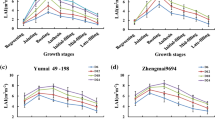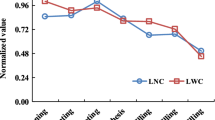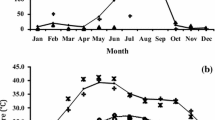Abstract
Nitrogen nutrition index (NNI) can monitor winter wheat nitrogen status precisely. Current studies by remote sensing data are to construct the above-ground biomass (AGB) and plant nitrogen concentration (PNC) with spectral indices, respectively, and then substitute them into established NNI equation. This leads to an accumulation of unavoidable error. Therefore, the objective in the study was to construct a direct NNI equation with remote sensing data to reduce this error. Field measurements data including AGB, PNC and canopy hyperspectral at different winter wheat growth stages during 2012/2013, 2013/2014, 2014/2015, 2015/2016 growing seasons in Beijing, China were collected. This study was endeavored to establish a vegetation index critical N dilution curve (Nvic) with two different spectral indices, RTVI (Red edge Triangular Vegetation Index) and NDVI/PPR (the ratio of the normalized difference vegetation index to the plant pigment ratio), which are sensitive to AGB and PNC, respectively. The vegetation index NNI (NNIvi) was calculated from the ratio between the NDVI/PPR and Nvic. Results showed that (1) Nvic can be described by an equation, Nvic = 1106.4(VIRTVI)−1.512, where RTVI ranged from 2.39 to 22.14; the determination coefficient (R2) was 0.57; (2) The NNI based on the above Nvic dilution curve was in good accordance with the classical NNI, with the root mean square error (RMSE), normalized RMSE (nRMSE) and normalized average error (NAE) of 0.194, 22%, and 11%, respectively. The critical nitrogen dilution model constructed in this study was available for winter wheat nitrogen status monitoring. Thus, this study offers a new method which was suitable and convenient for estimating the NNI of the winter wheat and it can reduce quadric error for constructing NNI through indices directly instead of inversing AGB and PNC.
You have full access to this open access chapter, Download conference paper PDF
Similar content being viewed by others
Keywords
1 Introduction
Nitrogen (N) is an indispensable chemical element for plant growing and an acquired agricultural input to increase yield [1, 2]. In the process of canopy growth in cereal crop, it needed a great deal of N [3]. Farmers applied more N fertilizer in fields than basic need during last few decades to ensure productivity [4]. However, excessive use of N did increase the economic burden of peasants, and even worth, it gives rise to environmental pollutions, such as soil acidification, eutrophication, emissions of greenhouse gas [5] and the contamination of surface and ground-water [6]. Improving N use efficiency has become growing importance concerning economic costs and environmental problems [2, 3].
Precise fertilization was proposed to reduce environmental problems caused by too much N fertilizer applied to the fields in modern agriculture [2]. Critical N concentration (Nc) means maximum growth could be achieved by applying the least but necessary nitrogen. Nitrogen nutrition index (NNI), as the ratio of plant nitrogen concentration (PNC) and corresponding Nc, is a suitable and reliable indicator of diagnosing of N in crops [7,8,9, 22]. N nutrition was considered perfect when NNI equals one; if NNI was great than one, N nutrition was considered luxurious; and N nutrition was insufficient if NNI was less than one [8].
A real-time and non-destructive monitoring technology need to be proposed to uphold the accurate detection of N in precision agriculture. Remote sensing methods were put forward by Lemaire et al. for the advantage of non-destructive and real-time during plant growth, and with this technology the NNI can be monitored rapidly in a largen region [10].
Applying optical sensors to diagnose NNI has been an important research topic in recent years [11,12,13, 19,20,21]. Some scholars tried to estimate the PNC and above-ground biomass (AGB) with N and dry biomass related vegetation indices, respectively, and then the estimated PNC and AGB were used to calculate the NNI [11, 12]. Cilia et al. Calculated the parameters (e.g., leaf actual N content and biomass) for the production of the NNI with MCARI/MTVI2 (a chlorophyll concentration index referred to as the Modified Chlorophyll Absorption Ratio Index/Modified Triangular Vegetation Index 2) and MTVI2 related to LAI, respectively. And then the method was applied on the airborne hyperspectral image to diagnose the crop N deficiency zone [12]. Xia et al. found that GreenSeeker sensor-based indices (VIs) can explain the variability of AGB and PNC, respectively, and then used to calculate spring maize NNI in Northeast China [7]. However, most of them contributed to inverse the N concentration and AGB first, and then get the NNI. In this process, Error will be accumulated and lead to a poor result. Little has been reported to construct NNI directly using spectral indices.
Therefore, the purposes of this study are as follows: (i) to construct a vegetation index critical nitrogen dilution model (Nvic) directly based on spectral indices for winter wheat in Beijing and then get the NNI; (ii) to compare the performance of the above NNI based Nvic with the traditional NNI.
2 Materials and Methods
2.1 Study Area and Experimental Design
Four years’ experiments were carried out in the same region, Xiaotangshan town (40°10′30″– 40°11′20″N, 116°26′01″ – 116°27′10″E), Changping District, Beijing, PR China and different growing seasons. 2012/2013, 2013/2014, 2014/2015, 2015/2016 were used to inverse the NNI. The climate in this study zone is A semi-humid continental monsoon climate. Field treatments include fertilizer rates at each growing season. Half nitrogen fertilizer was employed on the ground before seeding and the other half at the jointing stage (Table 1).
2.2 Data Acquisition
2.2.1 Biomass and N Concentration Data
Biochemical data was observed at jointing, booting and anthesis stages, during four growing season data in 2012/2013, 2013/2014, 2014/2015, 2015/2016. The AGB data was obtained at the same places where the hyperspectral data were measured through collecting 30–50 representative samples from each plot. All fresh winter wheat were devided into different parts, leaves, stems and spikes. Then all parts were sent to the oven and heated to 105 ℃ for almost one hour and then over dried down to 80 ℃ until the weight never changed, and their final dry weights were recorded using a delicate scale. Weights of stem and leaf were added up to calculate the AGB. The plant N concentration was measured with the micro-Kjeldahl way (Bremner and Mulvancy) [14].
2.2.2 Hyperspectral Data
Canopy reflectance data was collected by an ASD FieldSpec Pro FR spectroradiometer (Analytical Spectral Devices, Boulder, USA). A 1.4 nm sampling interval was set up between 350 nm and 1050 nm, and the sampling interval was set up between 1050 nm and 2500 nm was a 2 nm. In order to avoid the impact of change in the intensity of sunlight, spectral data were measured between 10a.m and 2p.m at a sunny day without cloud. The reflectance was acquired from the spectral radiance by using a 40 cm by 40 cm white BaSO4 reference panel, finally. In the same zone, ten spectral curves were observed at the same plot, and then the final spectral data were obtained by averaging the ten curves.
2.3 Spectral Indices
In this study, we endeavored to establish a vegetation index critical N dilution curve (Nvic) with two different spectral indices Red-edge Triangular Vegetation Index (RTVI) [15] and ratio of the normalized difference vegetation index to the plant pigment ratio (NDVI/PPR) [16] which are sensitive to AGB and PNC, respectively. The formulas of RTVI and NDVI/PPR are as follows:
Where Ri means the reflectance at band i.
2.4 Data Analysis
Calculating Nvic dilution curve needs to determine the Nc points where N neither limits nor enhances plant growth. As listed in Table 1, four years’ data, AGB and PNC under different N levels, were analyzed with the least significant difference (LSD 0.05) by the IBM SPSS version 19 (IBM Corporation, USA). N limited points were defined as points that the AGB would significantly increase if any additional N fertilizer were applied. Whilst, a N unlimited data points were defined as points that PNC would increase significantly but AGB would not change obviously with any additional N fertilizer applied. The construction process of traditional Nc dilution curve in this study were referred to Zhao et al. [17]. In the study, we attempt to construct Nvic curve directly from hyperspectral data, and the detailed Nvic construction based on the RTVI and NDVI/PPR are as follows: (1) all data points under each N treatment were token by RTVI and NDVI/PPR; (2) the N-limited treatments points were used to fit a simple straight line; (3) the N unlimited data points were averaged as the maximum RTVI value and then with the maximum RTVI value as a vertical line; (4) Nvic points were obtained as the intersection points; and (5) a power regression equation were fitted with these Nvic points, that is Nvic curve.
The measured NNI model was as follows:
The vegetation index was calculated according to the equation:
In Eqs. 3 and 4, Na represents the actual PNC, and Nc represents the winter wheat critical nitrogen content, Nvic is the vegetation index critical N.
Finally, the determination coefficient (R2), root mean square error (RMSE), normalized RMSE (nRMSE) and normalized average error (NAE) were employed to judge of the accuracy of the estimated model.
3 Results and Analysis
3.1 Plant N Concentration and Above Ground Biomass Under Different N Level
AGB were varied under different N application level at the vegetative growth period. As the amount of nitrogen application increased, AGB gradually increased. The AGB of the winter wheat develop from 1.863 to 10.632 t ha−1 at different growing periods, and seasons (Table 1). The AGB were significantly different under N0 to N2 applications, it indicated that N fertilizer had obviously influence on the crops growth. But it showed a different result under N2 and N3 fertilizer level in 2013/2016. During four growing seasons, AGB under different N treatments can be described by the following formula 5 at the 5% probability level.
where AGBi represented AGB at Ni application, respectively, i = 0, 1, 2, 3.
3.2 Nc in Winter Wheat
Calculating of the critical data points were conducted at the vegetative growth period in winter wheat in this study. For each sampling date, Nc and Nvic points would be acquired by two lines’ interception, the vertical and oblique lines. With increase of AGB and RTVI, the critical points value decreases; the trend lines of traditional critical dilution curve and the vegetation index critical N dilution curve could be described as the following equation (Fig. 1):
Where AGB is the above-ground biomass, VIRTVI is the vegetation index value of RTVI.
The Nc dilution model established by Justes et al. [18], Nc = 5.35·AGB−0.44, has been widely adopted as a classical model for wheat. The AGB-based Nc model (R2 = 0.792) in this study was similar to the model constructed by Justes et al. [18]. It can be used to validate the new NNI model. The trend of the Nvic dilution curve, NDVI/PPR value decreases with the increasing of RTVI, are same to the Nc However the coefficient a and b values of 1106.4 and 1.512, respectively for the VI-based are far greater than the coefficient (5.28, 0.457) for the AGB-based Nc curve. Coefficient b characterized the decline tendency of the PNC and NDVI/PPR value with plant growth, and therefore the Nvic is more sensitive to the N concentration. Results indicated that the increase of RTVI and AGB had similar influence on N dilution at vegetative stages.
3.3 Performance of the Vegetation Index NNIvi Based on Nvic
NNIvi were calculated with the procedure proposed in Sect. 2.4 was compared with the measured NNI are shown in Fig. 2. The Nvic-based NNI prediction models showed a good simulation result between measured NNI and the vegetation index NNI. The performance of the model was estimated with a RMSE value of 0.194, nRMSE value to be 22% and NAE were 11%. The results showed that studied method offered a new and useful tool for estimating the NNI.
4 Conclusions
This study proved that the developed critical N dilution model can be used for the diagnosis of nitrogen status in winter wheat in the study region. The good agreement between the traditional NNI and NNIvi supports the use of two vegetation index to substitute the AGB and PNC to inverse NNI. The method in this study offers a new and potential method which was suitable and convenient for estimating the NNI in winter wheat. Furthermore, it can reduce quadric error by constructing NNI through indices directly instead of inversing AGB and PNC.
References
Chen, P.: A comparison of two approaches for estimating the wheat nitrogen nutrition index using remote sensing. Remote Sens. 7(4), 4527–4548 (2015)
Zhao, B., Yao, X., Tian, Y.C.: New critical nitrogen curve based on leaf area index for winter wheat. Agron. J. 106(2), 379 (2014)
Yao, X., Ata-Ul-Karim, S.T., Zhu, Y., et al.: Development of critical nitrogen dilution curve in rice based on leaf dry matter. Eur. J. Agron. 55(2), 20–28 (2014)
Schröder, J.J., Neeteson, J.J., Oenema, O., Struik, P.C.: Does the crop or the soil indicate how to save nitrogen in maize production? Reviewing the state of the art. Field Crop Res. 66, 151–164 (2000)
He, Z., Qiu, X., Ataulkarim, S.T., et al.: Development of a critical nitrogen dilution curve of double cropping rice in South China. Front. Plant Sci. 8, 638 (2017)
López-Bellido, L., López-Bellido, R.J., Redondo, R.: Nitrogen efficiency in wheat under rainfed Mediterranean conditions as affected by split nitrogen application. Field Crop Res. 94, 86–97 (2005)
Xia, T., Miao, Y., Wu, D., et al.: Active optical sensing of spring maize for in-season diagnosis of nitrogen status based on nitrogen nutrition index. Remote Sens. 8(7), 605 (2016)
Padilla, F.M., Peña-Fleitas, M.T., Gallardo, M., et al.: Determination of sufficiency values of canopy reflectance vegetation indices for maximum growth and yield of cucumber. Eur. J. Agron. 84, 1–15 (2017)
Ata-Ul-Karim, S.T., Liu, X., Lu, Z., et al.: In-season estimation of rice grain yield using critical nitrogen dilution curve. Field Crops Res. 195, 1–8 (2016)
Lemaire, G., Marie-Hélène, J., François, G.: Diagnosis tool for plant and crop N status in vegetative stage theory and practices for crop N management. Eur. J. Agron. 28, 614–624 (2008)
Chen, P.F., Haboudane, D., Tremblay, N., et al.: New spectral indicator assessing the efficiency of crop nitrogen treatment in corn and wheat. Remote Sens. Environ. 114(9), 1987–1997 (2010)
Cilia, C., Panigada, C., Rossini, M., et al.: Nitrogen status assessment for variable rate fertilization in maize through hyperspectral imagery. Remote Sens. 6(7), 6549–6565 (2014)
Huang, S., Miao, Y., Zhao, G., et al.: Satellite remote sensing-based in-season diagnosis of rice nitrogen status in Northeast China. Remote Sens. 7(8), 10646–10667 (2015)
Bremner, J.M., Mulvancy, C.S.: Nitrogen-total. In: Page, A.L. (ed.) Methods of Soil Analysis, Part II, pp. 595–624. American Society of Agronomy, Madison (1982)
Chen, P.F., Nicolas, T., Wang, J.H., et al.: New index for crop canopy fresh biomass estimation. Spectrosc. Spectral Anal. 30(2), 512 (2010)
Jin, X., Li, Z., Feng, H., et al.: Newly combined spectral indices to improve estimation of total leaf chlorophyll content in cotton. IEEE J. Sel. Top. Appl. Earth Obs. Remote Sens. 7(11), 4589–4600 (2014)
Zhao, B., Tahir, A.U.K.S., Yao, X., et al.: A new curve of critical nitrogen concentration based on spike dry matter for winter wheat in Eastern China. PLoS ONE 11(10), e0164545 (2016)
Justes, E., Mary, B., Meynard, J.M., et al.: Determination of a critical nitrogen dilution curve for winter wheat crops. Ann. Bot. 74(4), 397–407 (1994)
Haiying, L., Hongchun, Z.: Hyperspectral characteristic analysis for leaf nitrogen content in different growth stages of winter wheat. Appl. Opt. 55(34), D151 (2016)
Cilia, C., Panigada, C., Rossini, M., et al.: Nitrogen status assessment for variable rate fertilization in maize through hyperspectral imagery. Remote Sensing 6(7), 6549–6565 (2014)
Eitel, J.U.H., Magney, T.S., Vierling, L.A., et al.: LiDAR based biomass and crop nitrogen estimates for rapid, non-destructive assessment of wheat nitrogen status. Field Crops Res. 159(159), 21–32 (2014)
Ata-Ul-Karim, S.T., Liu, X., Lu, Z., et al.: Estimation of nitrogen fertilizer requirement for rice crop using critical nitrogen dilution curve. Field Crops Res. 201, 32–40 (2017)
Acknowledgments
This research was funded by the National Natural Science Foundation of China (Grant no. 61661136003, 41471285,41601346) and National Key Technologies of Research and Development Program (2017YFD0201501, 2016YFD0300603-5).
Author information
Authors and Affiliations
Corresponding author
Editor information
Editors and Affiliations
Rights and permissions
Copyright information
© 2019 IFIP International Federation for Information Processing
About this paper
Cite this paper
Jianwen, W. et al. (2019). New NNI Model in Winter Wheat Based on Hyperspectral Index. In: Li, D., Zhao, C. (eds) Computer and Computing Technologies in Agriculture XI. CCTA 2017. IFIP Advances in Information and Communication Technology, vol 546. Springer, Cham. https://doi.org/10.1007/978-3-030-06179-1_16
Download citation
DOI: https://doi.org/10.1007/978-3-030-06179-1_16
Published:
Publisher Name: Springer, Cham
Print ISBN: 978-3-030-06178-4
Online ISBN: 978-3-030-06179-1
eBook Packages: Computer ScienceComputer Science (R0)







